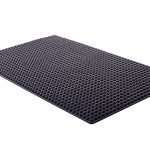Rubber flooring has long been a popular choice for commercial and industrial settings due to its durability, safety, and ease of maintenance. However, with advancements in design and technology, rubber flooring has also gained popularity in residential spaces. In this guide, we’ll explore the suitability of rubber floors for residential use, discussing their benefits, applications, and considerations for homeowners looking to incorporate this versatile flooring option into their homes.
What Is Rubber Flooring and How Is It Used in Residential Settings?
Rubber flooring is a resilient and durable flooring material made from natural or synthetic rubber compounds. It comes in various forms, including tiles, sheets, and mats, offering homeowners a versatile and customizable flooring solution for different areas of the home. Rubber flooring is commonly used in residential settings for high-traffic areas such as kitchens, bathrooms, laundry rooms, and home gyms, as well as in children’s playrooms, basements, and garage spaces. Its shock-absorbing properties, slip resistance, and easy maintenance make it an ideal choice for households seeking a practical and long-lasting flooring option.
What Are the Key Benefits of Using Rubber Floors in Residential Spaces?
Rubber floors offer numerous advantages for homeowners, including:
Durability:
Rubber flooring is highly durable and resistant to wear, tear, and abrasion, making it suitable for high-traffic areas and active households. Its tough and resilient surface can withstand heavy foot traffic, furniture movement, and impacts without showing signs of damage or deterioration, ensuring long-lasting performance and value for homeowners. With its exceptional durability, rubber flooring provides a reliable and low-maintenance flooring solution that stands the test of time, even in the busiest of households.
Comfort:
Rubber flooring provides excellent cushioning and support underfoot, reducing fatigue and discomfort for individuals who stand or walk for extended periods. Its shock-absorbing properties help alleviate pressure on joints and muscles, promoting comfort and well-being in kitchens, bathrooms, and other areas where prolonged standing is common. By prioritizing comfort and ergonomics, rubber flooring enhances the overall livability and enjoyment of indoor spaces, creating a cozy and inviting atmosphere for homeowners and their families.
Safety:
Rubber flooring offers superior slip resistance and traction, reducing the risk of slips, trips, and falls in wet or slippery conditions. Its textured surface provides a stable and secure footing, even in areas prone to moisture or spills, enhancing safety and peace of mind for homeowners and their families. With its reliable safety features, rubber flooring helps prevent accidents and injuries, particularly in households with children, seniors, or pets, ensuring a secure and worry-free living environment for all occupants.
Easy Maintenance:
Rubber flooring is easy to clean and maintain, requiring minimal effort and resources to keep it looking fresh and presentable. Its non-porous surface repels dirt, moisture, and stains, making it resistant to bacteria, mold, and mildew growth. Regular sweeping, mopping, or vacuuming is usually sufficient to maintain the cleanliness and hygiene of rubber floors. Ensuring a healthy indoor environment for occupants. With its hassle-free maintenance requirements. Rubber flooring offers convenience and peace of mind for homeowners. Allowing them to spend less time cleaning and more time enjoying their living spaces.
What Types of Rubber Flooring Are Available for Residential Use?
Rubber flooring comes in a variety of styles, colors, and patterns to suit different residential applications and design preferences:
Rubber Tiles:
Rubber tiles are interlocking or glue-down tiles that offer easy installation and customization for homeowners. They come in various sizes, thicknesses, and designs, allowing for endless possibilities in creating unique floor patterns and layouts. With their versatility and ease of installation. Rubber tiles provide homeowners with a flexible and customizable flooring solution that can adapt to their specific design preferences and space requirements. Whether used in kitchens, bathrooms, or entryways. Rubber tiles offer a durable and stylish option for enhancing the aesthetics and functionality of residential interiors.
Rubber Rolls:
Rubber rolls are large, seamless sheets of rubber flooring that provide a smooth and uniform surface for residential spaces. They are ideal for covering large areas quickly and efficiently, such as basements, home gyms, and playrooms. With their seamless design and resilient construction. Rubber rolls offer homeowners a practical and durable flooring solution that can withstand the rigors of daily use. Whether used for exercise or recreation. Rubber rolls provide a comfortable and supportive surface that enhances the safety and enjoyment of indoor activities.
Rubber Mats:
Rubber mats are portable and versatile flooring solutions that offer cushioning, traction, and protection for specific areas of the home. They come in various sizes, thicknesses, and textures. Therefore, making them suitable for use in kitchens, bathrooms, laundry rooms, and other high-traffic areas. With their slip-resistant surfaces and durable construction. Rubber mats provide homeowners with a reliable and practical flooring option that helps prevent slips, trips, and falls. Whether used as standalone mats or as part of a larger flooring system. Rubber mats offer homeowners a cost-effective and low-maintenance solution; consequently. They enhance the safety and comfort of their living spaces.
How to Choose the Right Rubber Flooring for Your Home?
When selecting rubber flooring for your home, consider the following factors:
- Functionality: Identify the specific needs and requirements of each room or space in your home. Such as durability, comfort, safety, and aesthetics. Select rubber flooring that not only offers the desired features and performance characteristics but also meets these needs effectively.
- Design and Style: Select rubber flooring in colors, patterns, and textures that not only complement your home’s interior design and decor but also enhance its overall aesthetic appeal. Consider coordinating with existing flooring materials, wall colors, and furnishings; consequently. You can create a cohesive and harmonious look throughout your home.
- Installation Method: Determine the most suitable installation method for your home, whether it’s interlocking tiles, glue-down rolls, or loose-lay mats. Consider factors such as ease of installation. Subfloor preparation, and long-term maintenance requirements when choosing the installation method that best fits your needs and preferences.
Conclusion: Elevating Residential Spaces with Rubber Flooring
In conclusion, rubber flooring offers numerous benefits for residential settings, including durability, comfort, safety, and easy maintenance. By incorporating rubber floors into kitchens, bathrooms, playrooms, and other areas of the home, homeowners can create functional, stylish, and comfortable living spaces. Additionally, this enhances their quality of life. With its versatility, resilience, and aesthetic appeal. Rubber flooring is an excellent choice for modern homeowners seeking practical and long-lasting flooring solutions for their homes. Therefore, investing in high-quality rubber flooring from reputable manufacturers is a wise decision that adds value, performance, and style to residential spaces.
Make sure to explore the rest of the site for more fascinating Blogs!











